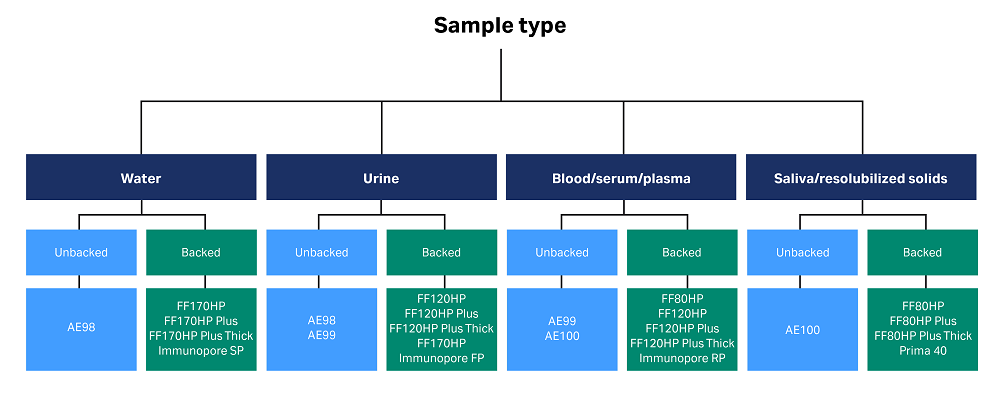Nitrocellulose membranes for lateral flow immunoassays
The nitrocellulose membrane is the heart of a lateral flow assay. It is where the target and control molecules are captured, and where the test results are read.
The role of the membrane is to immobilize the capture molecules (typically antibodies) at the test and the control lines in a way that their binding properties for their respective target molecule are preserved, and to guide the flow of the sample and the detection conjugate to the reaction area. To do this it must have a high and consistent protein binding capacity as well as porosity and wettability to allow a capillary flow of aqueous samples. The protein binding and capillary flow characteristics depend on the physical and chemical properties of the nitrocellulose membrane.
Cytiva offers a wide range of membranes for lateral flow immunoassay production.
- Unbacked membranes allow for use of the belt side or air side.
- Backed membranes are sturdier than unbacked membranes, and easier to use for manufacturing.
- Membrane families differ in their content of surfactants.
- Most membrane grades are available with different pore sizes providing a variety of capillary flow rates.
The correlation of assay sensitivity and flow rate follows an inverse square law. A larger pore size allows a faster flow rate, which will correlate to lower sensitivity. A developer who needs an assay with the ultimate sensitivity should select the membrane with the smallest possible nominal pore size.
 Infographic: Considerations for lateral flow membrane selection
Infographic: Considerations for lateral flow membrane selection
Whatman™ Faster Flow, Higher Performance Membrane (FFHP)
| Description |
A thinner membrane, 200 μm thick including backing, with reduced surfactant content. |
||
| When to use |
Quantificative asays or where you can reduce reagent dispensing to save cost. Designed for lateral flow assays. |
||
| Grade variants |
FF80HP – 60-100 second flow FF120HP – 90-150 second flow FF170HP – 140-200 second flow |
||
Whatman™ Higher Surfactant Membrane (FFHP Plus)
| Description |
Higher surfactant membrane to overcome hydrophobic issues. 200 μm thick membrane including backing. |
||
| When to use |
When using viscous samples and you wish to reduce reagent dispensing to save cost. |
||
| Grade variants |
FF80HP PLUS – 60-100 second flow FF120HP PLUS – 90-150 second flow FF170HP PLUS – 140-200 second flow |
||
Whatman™ Thicker Membrane (FFHP Plus Thick)
| Description |
Thicker membranes, 235 μm thick including backing and higher surfactant content. |
||
| When to use |
Optimised for when looking for easy swap-out of competitor grades. |
||
| Grade variants |
FF80HP – 60-100 second flow FF120HP – 90-150 second flow FF170HP – 140-200 second flow |
||
Whatman™ Post-Treatment Membrane (Immunopore™)
| Description |
Structurally different membrane as treated with surfactant post-drying, 200 μm thick. |
||
| When to use |
When looking for more consistent membrane performance than wet-treated surfactant products. |
||
| Grade variants |
Immunopore RP – 90-150 second flow Immunopore FP – 110-150 second flow Immunopore SP – 160-220 second flow |
||
Whatman™ High-Surfactant Membrane (Prima)
| Description |
High concentration surfactant nitrocellulouse membrane. Note: Product may contain some surface dust, due to manufacturing process |
||
| When to use |
When you need a very quick flow membrane. Works very well with dairy. |
||
| Grade variants |
Prima40 – 40 second flow Prima80 – 80 second flow Prima120 – 120 second flow |
||
Whatman™ Unbacked Membrane (AE)
| Description |
Unbacked nitrocellulose, 120 μm thick. |
||
| When to use |
For experienced users as trickier to handle, typically available at lower cost |
||
| Grade variants |
AE100 – 90-120 second flow AE99 – 120-160 second flow AE98 – 160-210 second flow |
||
Note: Flow time is measured by timing how long water takes to flow cross-web to completely fill 4 centimeters of membrane. This is an indication of how a sample will flow in your assay, but times with serum or other liquids will differ.
- Component selection in lateral flow assay development (blog)
- Membrane selection for lateral flow immunoassays (article)
- Custom lateral flow assay projects (article)
- Lateral flow assay troubleshooting guide & how to switch diagnostic membranes (article)
- Infographic: Considerations for lateral flow membrane selection
- Infographic: 10 Top Tips for lateral flow assay development
- Infographic: Navigating flow-through assays